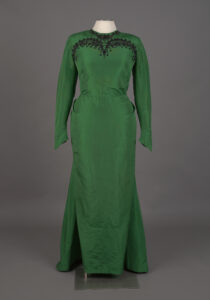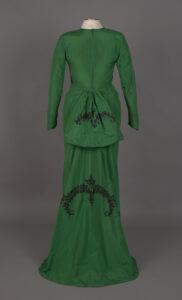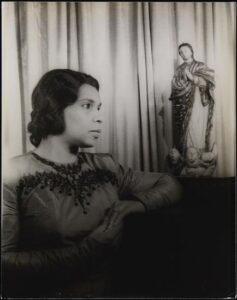The Voice & The Silk Gown: Marian Anderson’s Visit to J.P. McCaskey High School
This month, LancasterHistory examines the intricate workings of women’s historical fashion—highlighting the versatile designs, patterns, fabrics, and accessories throughout the centuries with a local touch. One garment that stands out in this examination has an international, national, and local story etched in its silk. Famed opera singer Marian Anderson came to Lancaster County in 1947 with an invitation to perform on J.P. McCaskey High School’s auditorium stage. This article takes an in-depth look at the beloved singer’s visits to the Susquehanna Valley and what she wore during her visits.
Renowned opera singer, performer, and activist Marian Anderson was born on February 27, 1897, in Philadelphia, Pennsylvania. Anderson broke racial barriers in entertainment in 1939, after the Daughters of the American Revolution (DAR) refused to allow the opera sing to perform at their Constitution Hall. Their refusal was believed to be a discriminatory act, and it would make front-page headlines resulting in widespread outrage. Anderson would later be invited by First Lady Eleanor Roosevelt to perform on the steps of the Lincoln Memorial to an integrated audience of more than 75,000 people. This performance would mark a major turning point in the early stages of the Civil Rights Movement. Anderson would later become one of the most prolific opera singers of the 20th century and the first Black woman to perform at the Metropolitan Opera in 1955.
The Program & Performance
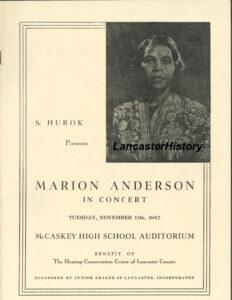
Almost a decade later, on November 11, 1947, the Junior League of Lancaster extended the invitation to Anderson to perform at J.P. McCaskey High School, with the proceeds from ticket sales benefitting the Hearing Conservation Center of Lancaster County. This would be Anderson’s first appearance on an American concert stage that season, as she had just finished touring in Cuba and Jamaica. This would not be the opera singer’s only stop in southeastern Pennsylvania. The previous year, Anderson headlined a concert at The Forum in Harrisburg and Lincoln University in Chester County honored her for her “Outstanding Contributions to the American People.”
Lancaster County newspapers documented Marian Anderson’s anticipated visit and subsequent arrival at J.P. McCaskey High School throughout the summer and fall of 1947. Anderson was originally set to perform in October, but due to an illness, staff, students, and residents would have to wait to see the celebrated singer in November.
While there are no known surviving recordings of Anderson’s performance at McCaskey High School, the original concert program can be found in LancasterHistory’s Leman and Herr Family Papers, 1791-1856 collection. The program features Anderson’s set list, which consists of a wide range of operatic and soulful songs. These diverse choices highlighted the versatility of Anderson’s low vocal ranges. The singer’s love of Germanic operas shines through in the program, with her performance of the German libretto Death of the Maiden (Der Tod Und Das Madchen), which the Intelligencer Journal called a “mournful” rendition. The list of songs also includes African American spirituals like heartfelt arrangements of “De Gospel Train” and “Dere’s No Hidin’ Place Down Dere.” Anderson’s commitment to the genre was both personal and cultural.
The Gown
Marian Anderson’s appreciation of fashion is an interesting topic for many researchers of historical dress. Her concert gowns are preserved and honored in various museums and exhibits throughout the United States. The green silk taffeta and black embroidered gown–currently on display at the Museum of the City of New York—is the same gown Anderson wore during her performance at J.P. McCaskey High School. The gown was a staple in the opera singer’s wardrobe. According to fashion conservator Callie O’Conner, it was one of Marian’s favorite dresses to perform in throughout 1947.
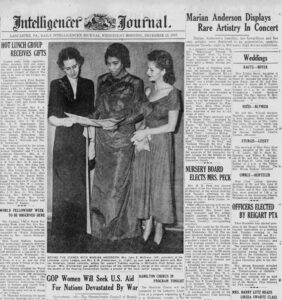
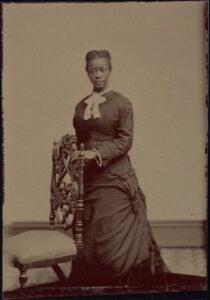
In a November article, The Intelligencer Journal gave readers a behind the scenes look at Anderson as she prepped for her performance at J.P. McCaskey High School. The photo captures the opera singer wearing the green silk taffeta and black embroidered gown while studying the concert program with two members of The Junior League of Lancaster. The image (Fig. 2.) gives a full view of the dress, whose draping resembles that of an early 1870’s bustle dress (Fig. 3.). A bustle is a softly draped protrusion at the back of the waist, created by the manipulation of fabric and drapery.
Anderson stated in her memoir, My Lord, what a Morning: An Autobiography: “I pay much more attention to my concert costumes than to my everyday clothes. I have threatened at times to spruce up my daily wear, but somehow have not succeeded.” Anderson was known for even packing her sewing machine when touring. Her McCaskey performance was no exception. The Sunday News mentioned that Anderson was sometimes her own couturiere (a fashion designer who makes and sells clothes for a specific client). “My [Marian] concert gowns,” she said, “used to be made by Schiaperlli of Paris and Anderson of Philadelphia.” Anderson’s love of fashion and veneration of her cultural identity were intertwined.
The songstress worked with many African American designers in New York City, emphasizing the importance of supporting Black-owned shops. Many of her unlabeled gowns are believed to be designed by Harlem-based dressmakers. Anderson is believed to have had close ties to Chambersburg, Pennsylvania native Zelda Wynn Valdes, an African American designer credited for designing the original Playboy Bunny waitress costumes. A prominent dressmaker in the African American community, Valdes also designed for other famous Black female entertainers including Ella Fitzgerald, Eartha Kitt, and Dorothy Dandridge.
The Legacy
Marian Anderson honored her love for the opera and the African American community through fashion with every gown she put on, and that includes the one she wore to her performance at J.P. McCaskey High School almost 80 years ago. Anderson’s legacy in the fashion and music communities lives on today. The media announced on February 28, 2024, that the Kimmel Center received a donation of $25 million to rename the Philadelphia Orchestra’s home, the Marian Anderson Hall. The renaming and rededication will officially take place 85 years after the DAR refused Anderson the opportunity to perform at Constitution Hall in Washington D.C. Anderson is also honored in her hometown of Philadelphia with the National Marian Anderson Museum, located at the opera singer’s historic home in the Southwest Center City. The museum houses some of her gowns, accessories, and other memorabilia.
Sources Consulted & Resources
- Womenswear (1870-1879) , Fashion History Timeline,https://fashionhistory.fitnyc.edu/1870-1879/
- My Lord, what a Morning: An Autobiography, Marian Anderson, page 219
- Marian Anderson’s Concert Gowns, Museum of the City of New York, https://www.mcny.org/story/marian-andersons-concert-gowns

